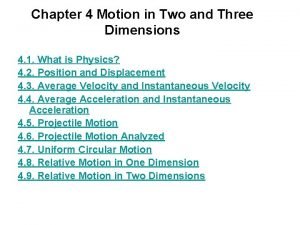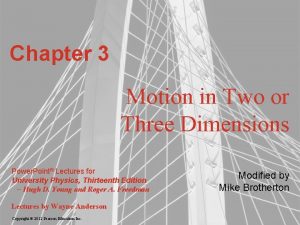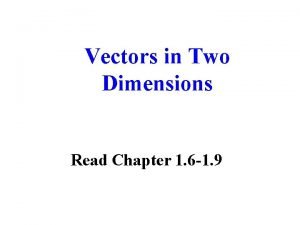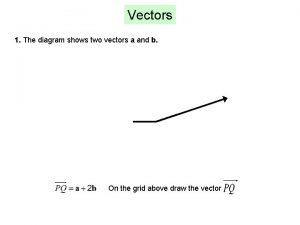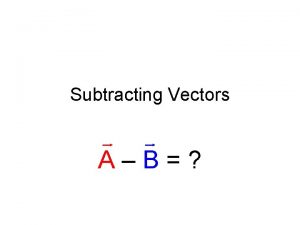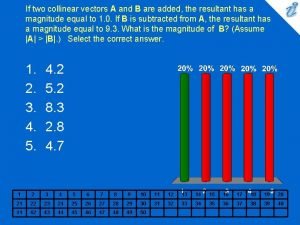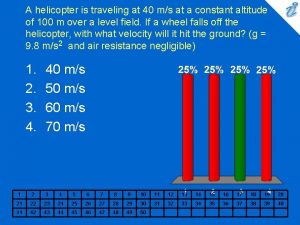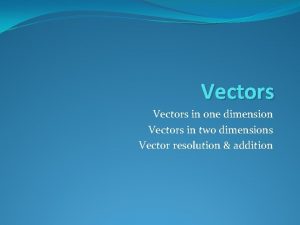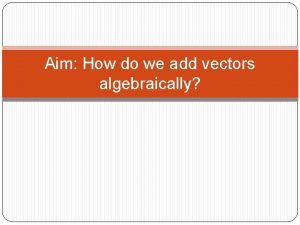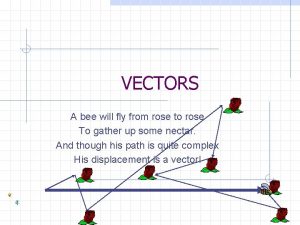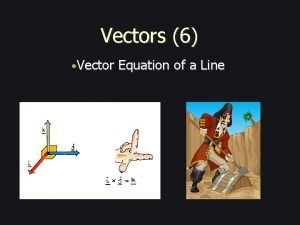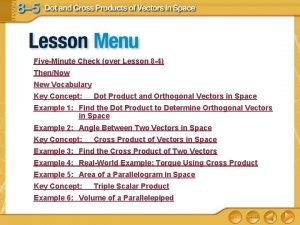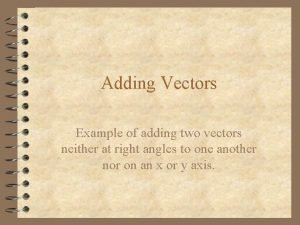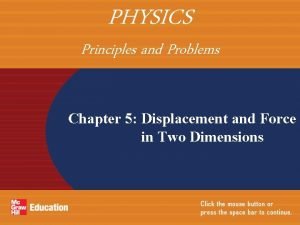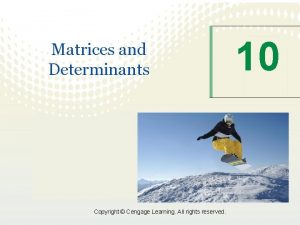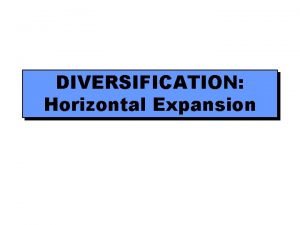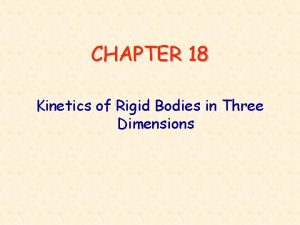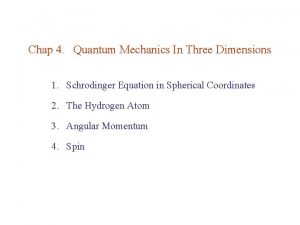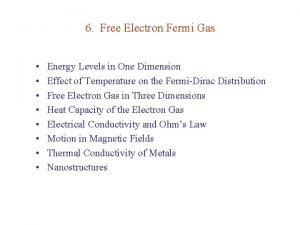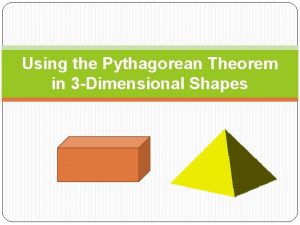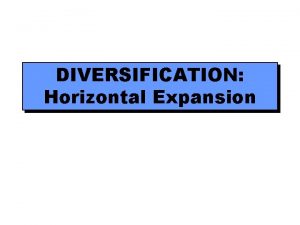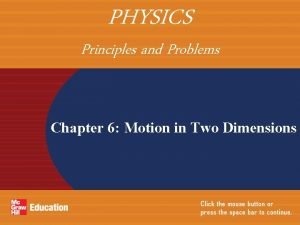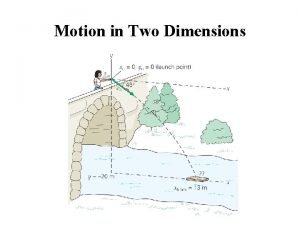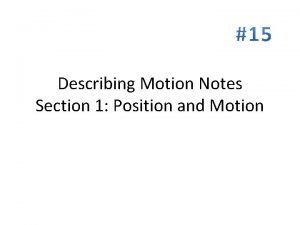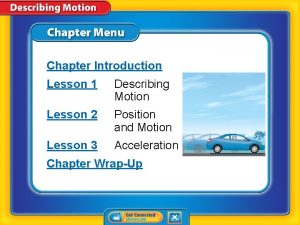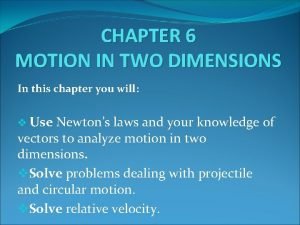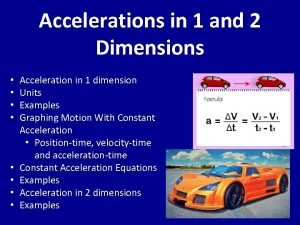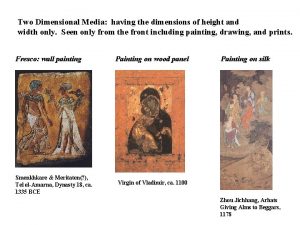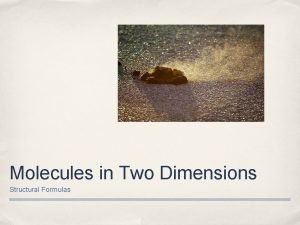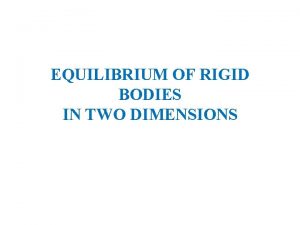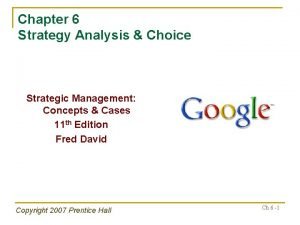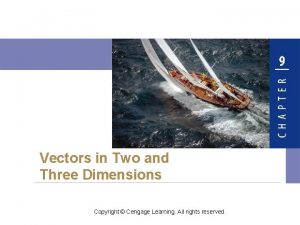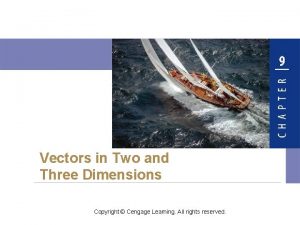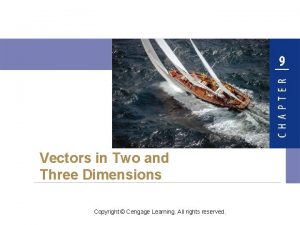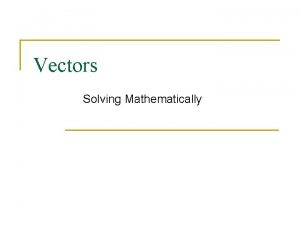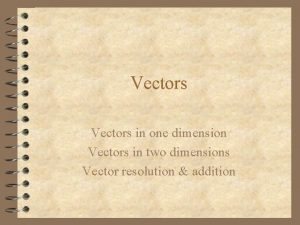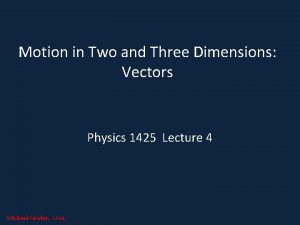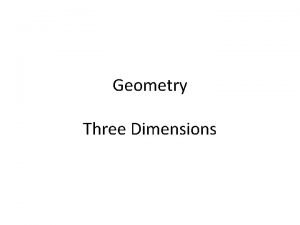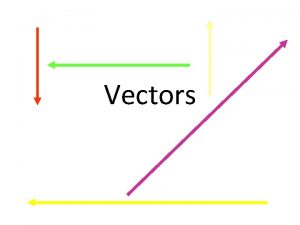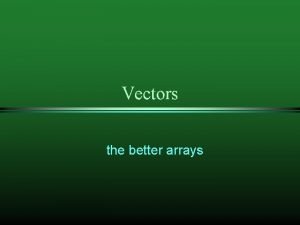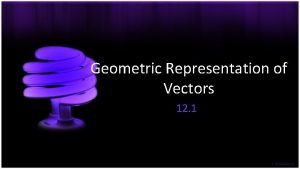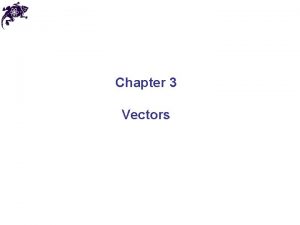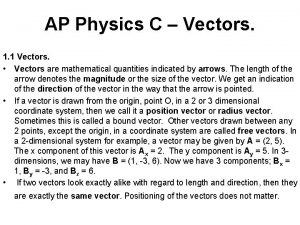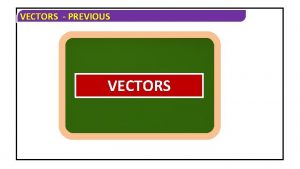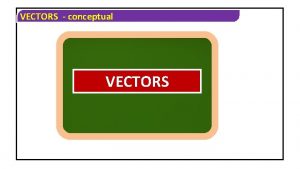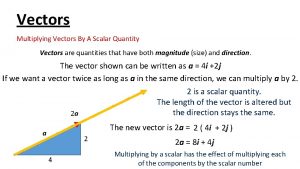Vectors in Two and Three Dimensions Copyright Cengage

















































- Slides: 49

Vectors in Two and Three Dimensions Copyright © Cengage Learning. All rights reserved.

Vectors in Two 9. 1 Dimensions Copyright © Cengage Learning. All rights reserved.

Objectives ► Geometric Description of Vectors ► Vectors in the Coordinate Plane ► Using Vectors to Model Velocity and Force 3

Vectors in Two Dimensions In applications of mathematics, certain quantities are determined completely by their magnitude—for example, length, mass, area, temperature, and energy. We speak of a length of 5 m or a mass of 3 kg; only one number is needed to describe each of these quantities. Such a quantity is called a scalar. On the other hand, to describe the displacement of an object, two numbers are required: the magnitude and the direction of the displacement. 4

Vectors in Two Dimensions To describe the velocity of a moving object, we must specify both the speed and the direction of travel. Quantities such as displacement, velocity, acceleration, and force that involve magnitude as well as direction are called directed quantities. One way to represent such quantities mathematically is through the use of vectors. 5

Geometric Description of Vectors 6

Geometric Description of Vectors A vector in the plane is a line segment with an assigned direction. We sketch a vector as shown in Figure 1 with an arrow to specify the direction. We denote this vector by. Point A is the initial point, and B is the terminal point of the vector. The length of the line segment AB is called the magnitude or length of the vector and is denoted by Figure 1 7

Geometric Description of Vectors We use boldface letters to denote vectors. Thus we write u=. Two vectors are considered equal if they have equal magnitude and the same direction. Thus all the vectors in Figure 2 are equal. Figure 2 8

Geometric Description of Vectors This definition of equality makes sense if we think of a vector as representing a displacement. Two such displacements are the same if they have equal magnitudes and the same direction. So the vectors in Figure 2 can be thought of as the same displacement applied to objects in different locations in the plane. 9

Geometric Description of Vectors If the displacement u = is followed by the displacement v= , then the resulting displacement is as shown in Figure 3 10

Geometric Description of Vectors In other words, the single displacement represented by the vector has the same effect as the other two displacements together. We call the vector the sum of the vectors and , and we write. (The zero vector, denoted by 0, represents no displacement. ) Thus to find the sum of any two vectors u and v, we sketch vectors equal to u and v with the initial point of one at the terminal point of the other (see Figure 4(a)). Addition of vectors Figure 4(a) 11

Geometric Description of Vectors If we draw u and v starting at the same point, then u + v is the vector that is the diagonal of the parallelogram formed by u and v shown in Figure 4(b). Addition of vectors Figure 4(b) 12

Geometric Description of Vectors If a is a real number and v is a vector, we define a new vector av as follows: The vector av has magnitude |a||v| and has the same direction as v if a > 0 and the opposite direction if a < 0. If a = 0, then av = 0, the zero vector. This process is called multiplication of a vector by a scalar. Multiplying a vector av by a scalar has the effect of stretching or shrinking the vector. 13

Geometric Description of Vectors Figure 5 shows graphs of the vector av for different values of a. We write the vector (– 1) v as –v. Thus –v is the vector with the same length as v but with the opposite direction. Multiplication of a vector by a scalar Figure 5 14

Geometric Description of Vectors The difference of two vectors u and v is defined by u – v = u + (–v). Figure 6 shows that the vector u – v is the other diagonal of the parallelogram formed by u and v. Subtraction of vectors Figure 6 15

Vectors in the Coordinate Plane 16

Vectors in the Coordinate Plane In Figure 7, to go from the initial point of the vector v to the terminal point, we move a units to the right and b units upward. We represent v as an ordered pair of real numbers. v = a, b Figure 7 where a is the horizontal component of v and b is the vertical component of v. 17

Vectors in the Coordinate Plane Using Figure 8, we can state the relationship between a geometric representation of a vector and the analytic one as follows. Subtraction of vectors Figure 8 18

Vectors in the Coordinate Plane 19

Example 1 – Describing Vectors in Component Form (a) Find the component form of the vector u with initial point (– 2, 5) and terminal point (3, 7). (b) If the vector v = 3, 7 is sketched with initial point (2, 4), what is its terminal point? (c) Sketch representations of the vector w = 2, 3 with initial points at (0, 0), (2, 2), (– 2, – 1) and (1, 4). 20

Example 1 – Solution (a) The desired vector is u = 3 – (– 2), 7 – 5 = 5, 2 (b) Let the terminal point of v be (x, y). Then x – 2, y – 4 = 3, 7 So x – 2 = 3 and y – 4 = 7, or x = 5 and y = 11. The terminal point is (5, 11). 21

Example 1 – Solution cont’d (c) Representations of the vector w are sketched in Figure 9 22

Vectors in the Coordinate Plane We now give analytic definitions of the various operations on vectors that we have described geometrically. Let’s start with equality of vectors. We’ve said that two vectors are equal if they have equal magnitude and the same direction. For the vectors u = a 1, b 1 and v = a 2, b 2 , this means that a 1 = a 2 and b 1 = b 2. In other words, two vectors are equal if and only if their corresponding components are equal. Thus all the arrows in Figure 9 represent the same vector. 23

Vectors in the Coordinate Plane Applying the Pythagorean Theorem to the triangle in Figure 10, we obtain the following formula for the magnitude of a vector. Figure 10 24

Vectors in the Coordinate Plane The following definitions of addition, subtraction, and scalar multiplication of vectors correspond to the geometric descriptions given earlier. Figure 11 shows how the analytic definition of addition corresponds to the geometric one. Figure 11 25

Example 3 – Operations with Vectors If u = 2, – 3 and v = – 1, 2 , find u + v, u – v, 2 u, – 3 v, and 2 u + 3 v. Solution: By the definitions of the vector operations we have u + v = 2, – 3 + – 1, 2 = 1, – 1 u – v = 2, – 3 – – 1, 2 = 3, – 5 2 u = 2 2, – 3 = 4, – 6 26

Example 3 – Solution cont’d – 3 v = – 3 – 1, 2 = 3, – 6 2 u + 3 v = 2 2, – 3 + 3 – 1, 2 = 4, – 6 + – 3, 6 = 1, 0 27

Vectors in the Coordinate Plane The following properties for vector operations can be easily proved from the definitions. The zero vector is the vector 0 = 0, 0. It plays the same role for addition of vectors as the number 0 does for addition of real numbers. 28

Vectors in the Coordinate Plane A vector of length 1 is called a unit vector. For instance, the vector w = is a unit vector. Two useful unit vectors are i and j, defined by i = 1, 0 j = 0, 1 (See Figure 12. ) Figure 12 29

Vectors in the Coordinate Plane These vectors are special because any vector can be expressed in terms of them. (See Figure 13. ) Figure 13 30

Example 4 – Vectors in Terms of i and j (a) Write the vector u = 5, – 8 in terms of i and j. (b) If u = 3 i + 2 j and v = –i + 6 j, write 2 u + 5 v in terms of i and j. Solution: (a) u = 5 i + (– 8)j = 5 i – 8 j 31

Example 4 – Solution cont’d (b) The properties of addition and scalar multiplication of vectors show that we can manipulate vectors in the same way as algebraic expressions. Thus, 2 u + 5 v = 2(3 i + 2 j) + 5(–i + 6 j) = (6 i + 4 j) + (– 5 i + 30 j) = i + 34 j 32

Vectors in the Coordinate Plane Let v be a vector in the plane with its initial point at the origin. The direction of v is , the smallest positive angle in standard position formed by the positive x-axis and v (see Figure 14). Figure 14 33

Vectors in the Coordinate Plane If we know the magnitude and direction of a vector, then Figure 14 shows that we can find the horizontal and vertical components of the vector. 34

Example 5 – Components and Direction of a Vector (a) A vector v has length 8 and direction /3. Find the horizontal and vertical components, and write v in terms of i and j. (b) Find the direction of the vector u = – + j. Solution: (a) We have v = a, b , where the components are given by and Thus v = 4, = 35

Example 5 – Solution cont’d (b) From Figure 15 we see that the direction has the property that Figure 15 Thus the reference angle for is /6. Since the terminal point of the vector u is in Quadrant II, it follows that = 5 /6. 36

Using Vectors to Model Velocity and Force 37

Using Vectors to Model Velocity and Force The velocity of a moving object is modeled by a vector whose direction is the direction of motion and whose magnitude is the speed. Figure 16 shows some vectors u, representing the velocity of wind flowing in the direction N 30 E, and a vector v, representing the velocity of an airplane flying through this wind at the point P. Figure 16 38

Using Vectors to Model Velocity and Force It’s obvious from our experience that wind affects both the speed and the direction of an airplane. Figure 17 indicates that the true velocity of the plane (relative to the ground) is given by the vector w = u + v. Figure 17 39

Example 6 – The True Speed and Direction of an Airplane An airplane heads due north at 300 mi/h. It experiences a 40 mi/h crosswind flowing in the direction N 30 E, as shown in Figure 16 40

Example 6 – The True Speed and Direction of an Airplane (a) Express the velocity v of the airplane relative to the air, and the velocity u of the wind, in component form. (b) Find the true velocity of the airplane as a vector. (c) Find the true speed and direction of the airplane. 41

Example 6(a) – Solution The velocity of the airplane relative to the air is v = 0 i + 300 j = 300 j. By the formulas for the components of a vector, we find that the velocity of the wind is u = (40 cos 60°)i + (40 sin 60°)j 20 i + 34. 64 j 42

Example 6(b) – Solution cont’d The true velocity of the airplane is given by the vector w = u + v: w=u+v= 20 i + 334. 64 j 43

Example 6(c) – Solution cont’d The true speed of the airplane is given by the magnitude of w: |w| 335. 2 mi/h The direction of the airplane is the direction of the vector w. The angle has the property that tan 334. 64/20 =16. 732, so 86. 6. Thus the airplane is heading in the direction N 3. 4 E. 44

Using Vectors to Model Velocity and Force is also represented by a vector. Intuitively, we can think of force as describing a push or a pull on an object, for example, a horizontal push of a book across a table or the downward pull of the earth’s gravity on a ball. Force is measured in pounds (or in newtons, in the metric system). For instance, a man weighing 200 lb exerts a force of 200 lb downward on the ground. If several forces are acting on an object, the resultant force experienced by the object is the vector sum of these forces. 45

Example 8 – Resultant Force Two forces F 1 and F 2 with magnitudes 10 and 20 lb, respectively, act on an object at a point P as shown in Figure 19. Find the resultant force acting at P. Figure 19 46

Example 8 – Solution We write F 1 and F 2 in component form: F 1 = (10 cos 45°)i + (10 sin 45°)j = F 2 = (20 cos 150°)i + (20 sin 150°)j = = + 10 j 47

Example 8 – Solution cont’d So the resultant force F is F = F 1 + F 2 – 10 i + 17 j 48

Example 8 – Solution cont’d The resultant force F is shown in Figure 20 49
 Cengage chapter 7
Cengage chapter 7 Motion in two and three dimensions
Motion in two and three dimensions Motion in two and three dimensions
Motion in two and three dimensions Vectors in 2 dimensions
Vectors in 2 dimensions The diagram shows a regular hexagon and a parallelogram
The diagram shows a regular hexagon and a parallelogram Two dimensional motion examples
Two dimensional motion examples The diagram shows two vectors that point west and north.
The diagram shows two vectors that point west and north. If two collinear vectors a and b are added
If two collinear vectors a and b are added A helicopter is traveling at 40m /s
A helicopter is traveling at 40m /s Like parallel force example
Like parallel force example Inner product space definition
Inner product space definition Vectors
Vectors Why cannot be vectors added algebraically
Why cannot be vectors added algebraically Vector dot product
Vector dot product Parallel vectors
Parallel vectors Cross product of two vectors
Cross product of two vectors Adding two vectors together
Adding two vectors together 5 displacement and force in two dimensions
5 displacement and force in two dimensions 4^x = 256
4^x = 256 Sequence and series cengage
Sequence and series cengage Matrices formula
Matrices formula Cengage anatomy and physiology
Cengage anatomy and physiology What is corporate scope
What is corporate scope Horizontal diversification
Horizontal diversification Kinetic of rigid body
Kinetic of rigid body Quantum mechanics in three dimensions
Quantum mechanics in three dimensions Free electron gas
Free electron gas Dimensions of justice
Dimensions of justice Three dimensions of critical thinking
Three dimensions of critical thinking Describe diversity
Describe diversity What is diversity
What is diversity Pythagorean theorem for 3d shapes
Pythagorean theorem for 3d shapes Three dimensions of corporate strategy
Three dimensions of corporate strategy Forward integration and backward integration
Forward integration and backward integration Vertical integration
Vertical integration Three dimensions of global inclusion
Three dimensions of global inclusion Intellectual standards of thinking
Intellectual standards of thinking Vy=gt
Vy=gt Two dimensions of political ideologies
Two dimensions of political ideologies Chapter 6 assessment physics
Chapter 6 assessment physics Velocity eq
Velocity eq Describing motion section 1
Describing motion section 1 Position and motion
Position and motion Chapter 6 study guide motion in two dimensions
Chapter 6 study guide motion in two dimensions Chapter 6 motion in two dimensions
Chapter 6 motion in two dimensions Dimension of acceleration
Dimension of acceleration Two dimensions of media
Two dimensions of media Molecules in two dimensions structural formulas
Molecules in two dimensions structural formulas Equilibrium of rigid bodies in two dimensions
Equilibrium of rigid bodies in two dimensions Strategic management chapter 6
Strategic management chapter 6

